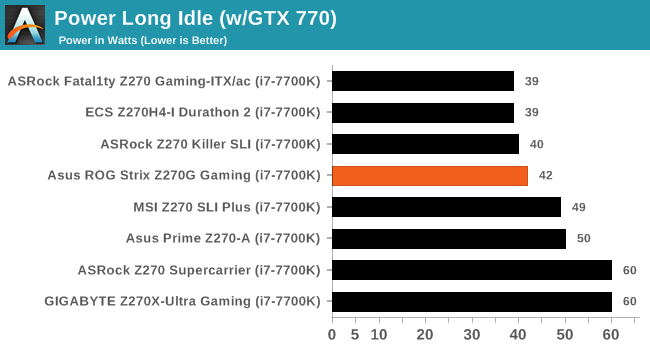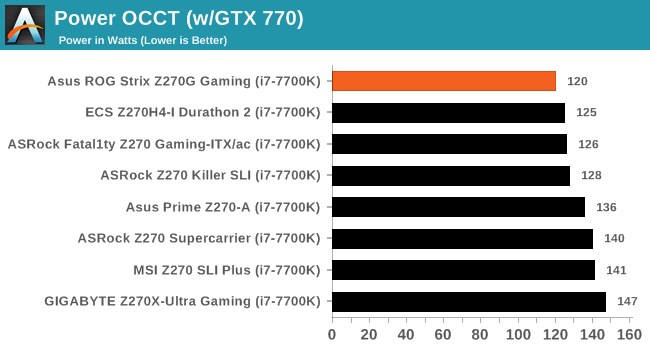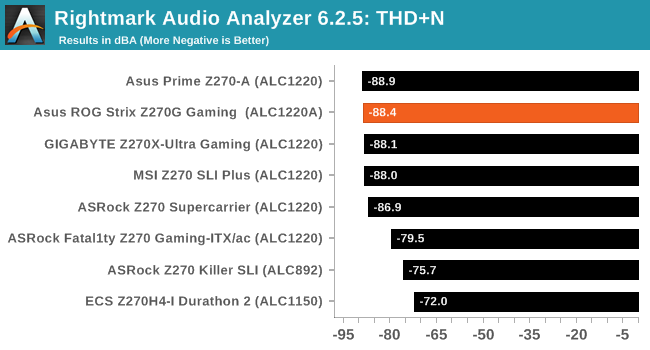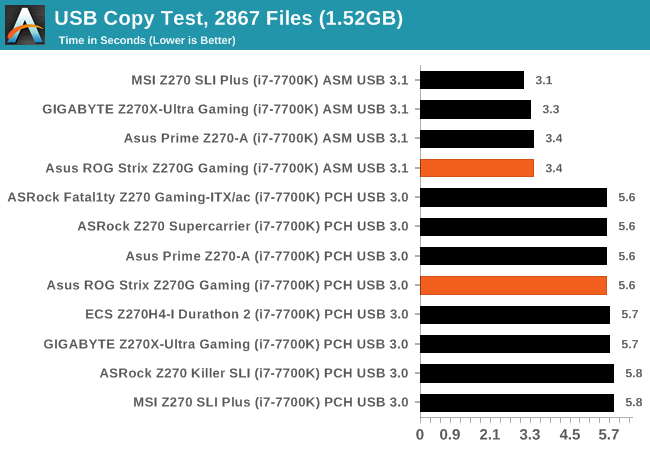The Asus ROG Strix Z270G Gaming Motherboard Review
by E. Fylladitakis on October 3, 2017 8:15 AM ESTSystem Performance
Not all motherboards are created equal. On the face of it, they should all perform the same and differ only in the functionality they provide - however, this is not the case. The obvious pointers are power consumption, but also the ability for the manufacturer to optimize USB speed, audio quality (based on audio codec), POST time and latency. This can come down to manufacturing process and prowess, so these are tested.
Power Consumption
Power consumption was tested on the system while in a single MSI GTX 770 Lightning GPU configuration with a wall meter connected to the Corsair AX1200i power supply. This power supply is Platinum rated, and as I am on a 230-240 V supply, leads to ~75% efficiency > 50W, and 90%+ efficiency at 250W, suitable for both idle and multi-GPU loading. This method of power reading allows us to compare the power management of the UEFI and the board to supply components with power under load, and includes typical PSU losses due to efficiency. These are the real-world values that consumers may expect from a typical system (minus the monitor) using this motherboard.
While this method for power measurement may not be ideal, and you feel these numbers are not representative due to the high wattage power supply being used (we use the same PSU to remain consistent over a series of reviews, and the fact that some boards on our test bed get tested with three or four high powered GPUs), the important point to take away is the relationship between the numbers. These boards are all under the same conditions, and thus the differences between them should be easy to spot.



The energy consumption of the Asus ROG Strix Z270G Gaming was lower than what we initially expected. Our initial assumption was that such a fully featured motherboard with RGB lighting would not be any different than its ATX counterparts, yet the energy consumption of the Asus ROG Strix Z270G Gaming proved to be significantly lower, with the smallest power delta between idle and load that we have seen to this date.
Non-UEFI POST Time
Different motherboards have different POST sequences before an operating system is initialized. A lot of this is dependent on the board itself, and POST boot time is determined by the controllers on board (and the sequence of how those extras are organized). As part of our testing, we look at the POST Boot Time using a stopwatch. This is the time from pressing the ON button on the computer to when Windows 7 starts loading. (We discount Windows loading as it is highly variable given Windows specific features.)

The booting times of the Asus ROG Strix Z270G Gaming proved to be very good, with the motherboard having a default boot time of just 13.2 seconds. Enabling quick boot and disabling most of the onboard controllers hardly aids the Micro ATX board to boot any faster, with 11.9 seconds being our best result.
Rightmark Audio Analyzer 6.2.5
Rightmark:AA indicates how well the sound system is built and isolated from electrical interference (either internally or externally). For this test, we connect the Line Out to the Line In using a short six inch 3.5mm to 3.5mm high-quality jack, turn the OS speaker volume to 100%, and run the Rightmark default test suite at 192 kHz, 24-bit. The OS is tuned to 192 kHz/24-bit input and output, and the Line-In volume is adjusted until we have the best RMAA value in the mini-pretest. We look specifically at the Dynamic Range of the audio codec used on board, as well as the Total Harmonic Distortion + Noise.


The implementation of the Realtek ALC1220A on the Asus ROG Strix Z270G Gaming is truly outstanding. The dynamic range reached 109.2 dB(A) and is the best that we have seen to this date on any Z270-based motherboard. The THD + Noise reading was -88.4 dB(A), which also is an outstanding result.
USB Backup
For this benchmark, we transfer a set size of files from the SSD to the USB drive using DiskBench, which monitors the time taken to transfer. The files transferred are a 1.52 GB set of 2867 files across 320 folders – 95% of these files are small typical website files, and the rest (90% of the size) are small 30 second HD videos. In an update to pre-Z87 testing, we also run MaxCPU to load up one of the threads during the test which improves general performance up to 15% by causing all the internal pathways to run at full speed.

The USB 3.0 performance on the Intel USB 3.0 ports is typical and directly comparable to that of any other Z270-based motherboard. The ASMedia USB 3.1 also works well with our mSATA USB 3.1 Type-C device, reducing the time needed for the transfer down to 3.4 seconds.
DPC Latency
Deferred Procedure Call latency is a way in which Windows handles interrupt servicing. In order to wait for a processor to acknowledge the request, the system will queue all interrupt requests by priority. Critical interrupts will be handled as soon as possible, whereas lesser priority requests such as audio will be further down the line. If the audio device requires data, it will have to wait until the request is processed before the buffer is filled.
If the device drivers of higher priority components in a system are poorly implemented, this can cause delays in request scheduling and process time. This can lead to an empty audio buffer and characteristic audible pauses, pops, and clicks. The DPC latency checker measures how much time is taken processing DPCs from driver invocation. The lower the value will result in better audio transfer at smaller buffer sizes. Results are measured in microseconds.

Asus takes DPC latency very seriously and the ROG Strix Z270G Gaming is no exception. Our maximum reading was 62 μs, an excellent performance figure and notably better than what we usually expect from most motherboards.










26 Comments
View All Comments
DanNeely - Tuesday, October 3, 2017 - link
Just to try and head the peanut gallery off at the pass. Based on something that either Ian or Ryan said a few days ago on twitter this should be the last board from the Z270 backlog.Gothmoth - Tuesday, October 3, 2017 - link
take a look at the mainboard reviews here an anandtech and tell me anandtech is not biased.count the intel reviews then count the AMD reviews.
full reviews for intel boards and "overviews" for AMD boards.
and no, the reason is not that there are less AMD boards then intel boards.
why not at least review the few AMD boards that exist?
they rather preview Z270 boards then spending time on threadripper or AM4 boards.
while AMD sells better in europe than intel for the past 3 month.
Ian Cutress - Tuesday, October 3, 2017 - link
We've got two AMD motherboard reviews being edited this week for next week. Our new motherboard review team, all of whom are in different corners of the world, is slowly coming up to speed. In case you didn't notice, E.Fyll has been doing our Z270 reviews this year and only Z270 - the other reviewers are taking on other chipsets - Joe for X299, Gavin for AM4. E.Fyll is likely to take TR4 now, and when Patrick gets back from his vacation, he's likely to take the Z370 content.MajGenRelativity - Tuesday, October 3, 2017 - link
I'm looking forward to seeing more motherboard reviews :) I appreciate the quality contentFlunk - Tuesday, October 3, 2017 - link
Since Anandtech doesn't buy the gear they review, they can only review whatever the manufacturer sends them. If ASUS sends them 4 Intel boards and one AMD board, that's what they review.smilingcrow - Tuesday, October 3, 2017 - link
"while AMD sells better in europe than intel for the past 3 month."Is that based on the data for one webtailer or the whole of Europe?
For all CPUs or just a range?
I doubt that AMD currently have the capacity to supply that much of the retail market but if that's what they have done it's amazing.
Gothmoth - Tuesday, October 3, 2017 - link
yeah i will buy Z270 now that Z370 is released in 2 days.....great job on doing timely reviews. tremendous job.
Ian Cutress - Tuesday, October 3, 2017 - link
As per my tweet a few days ago, just getting the last ones out. The platform is still going to exist for a couple of years, with retail sales of both motherboards and processors. Reviews are still relevant.reckless76 - Tuesday, October 3, 2017 - link
Just wanted to chime in since you're being forced to defend yourself, that I appreciate all your reviews, whenever they're posted. I'm not in the market for new parts now, but I have in the past and will be again in the future. Your site has always been an invaluable resource, so thank you.notR1CH - Wednesday, October 4, 2017 - link
I bought this board based only on the spec sheet when the 7700k came out as there were no reviews at the time. It's nice to know that I got a good board even if the review is late, in particular I had no idea the onboard audio was that good, I figured it was all just marketing.